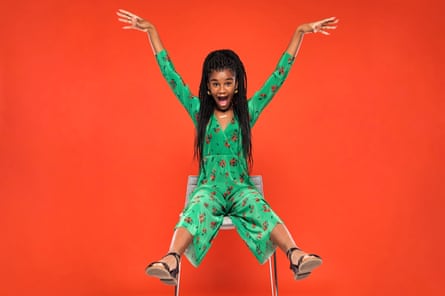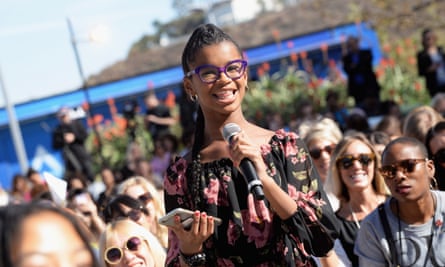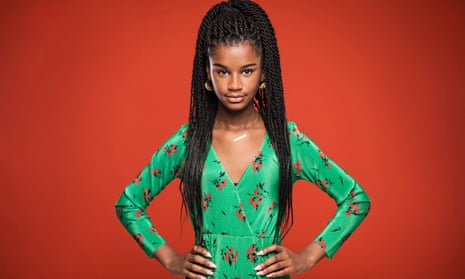When I arrive at the photography studio to meet the education activist Marley Dias, I am surprised to find the shoot is long over. The 14-year-old is sitting patiently, her luggage packed, coat neatly slung over her lap, waiting. The photographer explains the early finish is because they got all the pictures they needed with Dias near-immediately; that she is the perfect subject to work with.
This was perhaps the first inkling of what would become abundantly clear during our interview: Marley Dias is a pro. Despite her tender years, the campaigner for diverse children’s books – which took her from her New Jersey home town to the White House – carries herself with a mature confidence, and a wherewithal perhaps born from deeply held conviction.
“We live in an unfair world and we have to fight,” she says, leaning forward in her seat, her elbow resting on the table. She is wearing a vivacious green jumpsuit, the outfit of someone who is not afraid to be seen. Her role is, Dias explains, to “motivate young girls, regardless of their race or their experience, to get out there and do the things you love and that will help other people”.
Dias was 10 the day she came home from school to eat pancakes with her mother and vented her frustration at being assigned to read Where the Red Fern Grows by Wilson Rawls. Again.

“It is one of those ‘classic books’ that’s existed in our school systems for so long. My great-grandparents remember when that book came out. I read it last year and it was still assigned. Every single year they wanted us to read a book about a white boy and his dog.”
Dias decided – at 10 years old – to collect books with black girl leads to raise awareness of books with diverse characters and the overrepresentation of books with white leads in the school system. Her target was 1,000 books, which she would then send to a school in Jamaica that her mother had attended. “I didn’t pick my own school because I realised that even in all-black spaces like Jamaica, where it is majority black people, they don’t see themselves, and the narratives of white people are still being pushed on to people.”
She created a hashtag, #1000BlackGirlBooks, which started to pick up pace and soon catapulted the young Dias into the limelight. “Two of the first books I collected were Grace for President by Kelly DiPucchio and Brown Girl Dreaming by Jacqueline Woodson,” she says. Since the campaign launch in 2016 she has collected well over 12,000 books, organised a reading party at the White House, shared a stage with Oprah Winfrey, appeared on The Ellen DeGeneres Show and guest-edited a special edition of Elle magazine – all while keeping up with her classes and doing her homework. What is that like for her? “I don’t really bring it up at school. Although I’m sure the kids at school know because they follow me on Instagram.”
Hearing Dias tell the stories of when those worlds collide is one of just a few moments where she seems her age (the other times are when she notes what trainers I’m wearing, and playfully groans when I say I still have more questions). She giggles through a story about how her friends responded to her getting the phone number of Rowan Blanchard, an actor on the Disney Channel, at the Teen Vogue Summit.
“They just freaked out! And obviously I don’t give out people’s phone numbers, but I used to love her and that whole show and then two years later … wow.
“And then another thing,” she continues, giddily, “was at that same summit, Reese Witherspoon – she’s a great actor, a huge celebrity. I don’t watch Reese Witherspoon movies though, I’m too young – but her daughter and I are friends now! We’re actually friends! That’s a weird thing to think about. It’s fun but I also don’t want people to think that I do it just because of those relationships.”
Dias reflects that although she isn’t as famous as, for example, some child actors, she has begun to empathise with how they might feel. “They always say: ‘I’m just a kid and I want to be just a normal kid.’ And I understand that because I know that I don’t want to feel like a weirdo. I can get lonely sometimes, too, because not many girls my age are doing what I do. But I am doing this because I love to read, I love books, I love being here, I am passionate.”

For Dias, passions have power and are a vital part of an energy that can “change the world”. “If you’re passionate about makeup, and you use that passion to highlight social issues, people will connect with your authenticity.
“One author that I love is Tomi Adeyemi; she wrote Children of Blood and Bone, an African fantasy story. We don’t often see black people in futuristic and magical worlds. So she’s taken a genre that has always been a majority white space, and she’s taken some of her own history of being an African American person, and she’s moulded that into something that’s not just a slavery story and is about the history of Africa and in a positive light. For the black kids out there, who really love fantasy but never see themselves, they now feel a whole new level of connection. That’s important.”
The girl activist has become a prominent figure in our time – Greta Thunberg, the climate change activist; Malala Yousafzai, the Nobel prize winner campaigning for girls’ education; and Emma Gonzales, a US advocate for gun control, to name just three. Why are we seeing fewer teenage boys fulfil these roles?
“I think our parents push for us [girls] to understand that we’re connected to other people at a younger age. Boys’ games are about conflicts, and fake fighting. And that translates into real life. You see it in school; if something bad happens, boys say: ‘I’m not with them, I don’t connect to them, I’m separate.’ But with girls, we play family, we play house. We think about others. Maybe that [has made] us more inclined to be activists.”
Dias’s debut, Marley Dias Gets it Done: And So Can You! is an autobiography-cum-toolkit for the young activist girl. A collection of stories and advice, it also provides an insight into Dias’s world, from the clothes she likes to the encouraging influence of her parents (Dias urges all her teen readers to listen to their parents). The book also spends time emphasising the importance of reading for young people, but it does not talk about economics and the relationship between wealth and educational outcomes for people of colour.
“There’s a lot of economic segregation where I live, and it’s a very important issue. The only reason why it’s not in the book is because I just didn’t really know a lot about it at the time I was writing. I was 11. I address economic inequality now, in my speaking engagements, but at the time I wasn’t aware. I could have got my mum to help me, she would have been great, but then the book wouldn’t be from me.”
Dias’s mother, Dr Janice Johnson Dias, is in the room during our interview (standard practice when interviewing a minor). Johnson Dias is the founder of GrassROOTS, a community foundation focusing on women’s public health, especially those from lower-income households. I ask Johnson Dias how she resisted the urge not to nudge her daughter into covering a subject so close to her heart?
“The role of parents is to make space for their children’s real voice, even their mistakes. Not that I think there’s a lot of mistakes, but I’m an economic sociologist and so thinking about literacy in our own neighbourhood, I just know way too much. It wouldn’t have sounded like her. It wouldn’t have been her. It wouldn’t be Marley Dias getting it done, it would be Janice Johnson getting it done.”

I’m curious about how Dias’s life has changed from when she started #1000BlackGirlBooks under the Obama presidency to now, organising as a young black girl in Trump’s America. Does she feel optimistic about the future? Does her generation?
“I do not think my generation is optimistic. All we ever hear is bad news; we’re put into a fear-mongering world where we’re told that things are bad, that bad things are always happening and the world’s going to end in 2050. And we don’t see [enough of] the good people like Greta, or the [organisers of] March for Our Lives, and we don’t see people like me. We’re just not highlighted in the same way. So if we only talk about the pessimistic things, we’ll have a pessimistic generation.
“But we can become optimistic – in a realistic way – if only we knew that there really are people out here fighting, trying to change the world.”
Marley Dias Gets it Done: And So Can You is out now. To order a copy for £8.79, go to guardianbookshop.com
